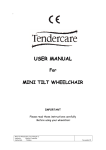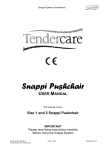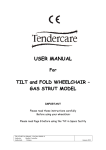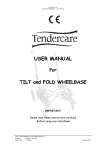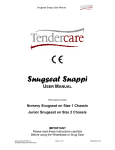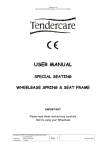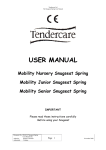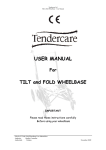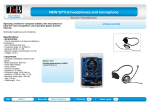Download Aluminium Mini Tilt User Manual
Transcript
Mini Tilt Wheelchair Mini Tilt Wheelchair User Manual IMPORTANT Please read these instructions carefully Before using the Wheelbase or Interface Document No: 054-01 v6 Mintilt (newstyle) user manual.doc Page 1 of 28 January 2014 Mini Tilt Wheelchair Push Handle Half Height Back Canvas Armrest Tilt Lever Attendant Brake Fig 0.1: 14” Mini Tilt with standard accessories (partial tilt) Handle Clamping Lever Backrest Lock Full Seat Canvas Fig 0.2: 14” Mini Tilt folded for transport Document No: 054-01 v6 Mintilt (newstyle) user manual.doc Page 2 of 28 January 2014 Mini Tilt Wheelchair Item Description Page 1 Who to contact in difficulty 2 Intended User 2.1 Size and weight 3 Unpacking 4 Preparing the wheelchair for use 4.1 Unfold and lock the backrest 4.2 Adjust the push handles 4.3 Fit and adjust the armrests 4.4 Footrests (optional) 4.5 Tilt in space 4.6 Tyres and brakes 4.7 Rear wheel position 4.8 Tipping the wheelchair 4.9 Accessories - Tray 6 7-8 8-9 10 10 - 11 11 12 12 – 13 14 14 - 16 5 User Instructions 5.1 Getting into the wheelchair 5.2 Getting out of the wheelchair 5.4 Sideways transfer 16 16 16 16 6 Attendant Pushing 6.1 Pushing 6.2 Brakes 6.3 Comfort 6.4 Lifting and general safety 17 17 17 18 18 7 Cleaning 18 8 Maintenance 8.1 Routine maintenance 8.2 Six-monthly maintenance 19 19 19 9 Warranty 20 10 Transport the wheelchair 10.1 Preparing the wheelchair for transport 10.2 Attaching wheelchair 11 Repairs Document No: 054-01 v6 Mintilt (newstyle) user manual.doc 4 4 4-5 6 20 20 – 22 23 – 25 25 Page 3 of 28 January 2014 Mini Tilt Wheelchair 1: Who to contact in difficulty Tendercare Ltd. PO BOX 3091, Littlehampton, BN16 2WF Tel: (01903) 726161 Fax: (01903) 734083 Email: [email protected] Web: www.tendercareltd.com 2: Intended user This product benefits from a tilt in space facility and has been designed for use as a wheelchair or wheelbase for use with special seating systems. It is available in three seat widths of 305mm (12”), 356mm (14”) and 406mm (16”). These instructions apply to all sizes. The wheelchair has 2 fixed rear wheels and 2 front castor wheels for easy steering. The backrest can be folded for transit. The armrests lift off for easy side transfer and the push handles are adjustable in height and angle to suit a wide range of attendants. The maximum carrying weight is to include occupant, seating systems and all accessories and should not exceed 57Kg (9 stone). 2.1: Size and weight: All sizes and weights are given as a guide. Tendercare ltd reserves the right to amend specifications at any time as part of their product development programme. Weight*: 12”: 16 kg 14”: 16.8 kg 16”: 17.6 kg *Weight includes complete frame and the following standard accessories: Armrests, half height canvas set, attendant brakes and push handles. The occupant’s safety is your responsibility. As such we recommend that you read the complete user manual prior to using your wheelchair. Document No: 054-01 v6 Mintilt (newstyle) user manual.doc Page 4 of 28 January 2014 Mini Tilt Wheelchair Dimensions (mm) A B C Dimensions (mm) A B C Document No: 054-01 v6 Mintilt (newstyle) user manual.doc 12” 670 500 1050 Mini Tilt Open (no tilt) 14” 670 550 1050 16” 715 565 1050 12” 860 500 590 Mini Tilt Folded 14” 860 550 590 16” 860 565 590 Page 5 of 28 January 2014 Mini Tilt Wheelchair 3: Unpacking The wheelchair is delivered in a cardboard carton approximate weight 20 kg and size 630mm wide x 595mm deep x 890mm high. Warning the transit carton is heavy so moving and unpacking must be done with care. Observe all lifting and handling regulations. 1. Stand the carton upright making sure it is supported and cannot fall over. Open the carton and remove any packages or packing, which could obstruct the removal of the frame. 2. Carefully pull out the wheelchair and check that you have the following items: Item 1 2 3 Component QTY. Mini Tilt Wheelchair Armrests User Manual Yes No 1 2 1 IMPORTANT: If any items are damaged or missing, then please contact Tendercare, preferably by email at [email protected] or alternatively please call us on (01903) 726161 within 36 hours of delivery. After unpacking and checking you have all components and they are in good condition dispose of the packaging at your local recycling centre. Alternatively retain and reuse. 4: Preparing the wheelchair for use Warning: When assembling the wheelchair for use, ensure that you hold the frame so that you avoid any danger of catching your fingers in moving parts. Keep children clear of the wheelbase during opening and folding. Document No: 054-01 v6 Mintilt (newstyle) user manual.doc Page 6 of 28 January 2014 Mini Tilt Wheelchair 4.1: Unfold and lock the backrest: The Mini Tilt will be supplied complete, but in its folded position. First unfold the back by lifting the backrest as far as it will move (see left). Please note that the locking bolts must be in the “unlocked” position as shown, if they are extended into the “locked” position it will not be possible to move the back into its full upright position. Fig 4.1.1 There are 2 bolts located either side of the backrest near the hinge. With the back is in its full upright position, lock the bolts by moving the black ball knob towards the outside of the chair so it moves out of its docking position. The bolt is spring-loaded and will drop down into the receiver tube in the frame. Fig 4.1.2 Always ensure that the bolts have moved the full length of the slot, and cannot move any further. To release the locking bolts, lift the full length of the slot and move towards the inside of the chair. This will restore them to the unlocked position and allow the backrest to be folded for transport. Note: Always support the backrest when folding to avoid it dropping down too quickly. We recommend holding the backrest by the rear crossbar when folding. Fig 4.1.3 Document No: 054-01 v6 Mintilt (newstyle) user manual.doc Page 7 of 28 January 2014 Mini Tilt Wheelchair 4.2: Adjust the push handles: The Mini Tilt has clamp locking push handles that can be adjusted in height, and also rotated to any angle as needed. To adjust the handle, first loosen the clamping lever by rotating it anti-clockwise as shown. Fig 4.2.1 Once loose, simply move the handle to the required height and angle, and lock by rotating the clamping lever in the opposite direction until the handle no longer moves. The push handles have a safety mechanism, which prevents the handle from being fully removed from the frame. IMPORTANT: Always ensure that the push handles are firmly locked before using the wheelchair. Fig 4.2.2 Document No: 054-01 v6 Mintilt (newstyle) user manual.doc Page 8 of 28 January 2014 Mini Tilt Wheelchair It is also possible to adjust the position of the lever arm without releasing the handle. To do this, place your thumb or a finger on the red button, and pull back on the lever. Then simply rotate the lever arm to the desired position and release. The lever is spring-loaded and will snap back into its normal working position. IMPORTANT: Do not attempt to hang anything on the clamping lever. The leaver is not intended to carry load and doing so may break the lever. Fig 4.2.3 4.3: Fit and adjust the armrests: To fit the armrest, loosen thumbscrew A (turn anti clockwise) and release the spring catch B by turning 90 degrees in either direction. Whilst holding catch B in this position, push the armrest into the socket. Ensure that the holes on the armrest stem are facing catch B. To lock: Release catch B when the armrest is at the desired height, and tighten thumbscrew A to secure. Fig 4.3.1 To adjust the height, loosen the thumbscrew and release catch B, adjust the height and lock as described above. TIP: When folding the wheelchair for transport, always remove the armrest first, and then fold the back. Document No: 054-01 v6 Mintilt (newstyle) user manual.doc Page 9 of 28 January 2014 Mini Tilt Wheelchair 4.4: Footrests (optional): The footrests are fitted to the wheelchair when it is supplied (if ordered). They can be moved forward and back, up and down. The footplate can be lifted to the vertical position for easy transfers in and out of the wheelchair. To adjust the footrest depth: Loosen thumbscrew ‘C’ (see right), until the footrest stem is free to move. Move the footrest stem to the desired location, then re tighten the thumbscrew. Thumbscrew C Fig 4.4.1 To adjust the footrest height: Using a 5mm hexagon key loosen the screw on the side of the footrest (see left). Move the footrest to the desired height and retighten the screw. IMPORTANT: Make sure the screw fits into one of the indentations in the support rod. Fig 4.4.2 Lifting the footplate: The footplates can be lifted into the vertical position for easier transfers in and out of the wheelchair. To do this, simply hold the inside edge of the footplate and lift up. Document No: 054-01 v6 Mintilt (newstyle) user manual.doc Page 10 of 28 January 2014 Mini Tilt Wheelchair 4.5 Tilt in Space: The angle of the seat and backrest can be adjusted to any angle between upright and fully reclined. To recline the seat, put the brakes on and stand behind the wheelchair. Holding both push handles squeeze the ‘tilt lever’ (see right) and push down evenly on both handles. Release the lever when the seat is at the required angle. To bring the seat upright, put the brakes on and stand behind the wheelchair. Holding both push handles squeeze the tilt lever and lift evenly with both hands. Release the lever when the seat is at the required angle. Fig 4.5.1 Important: Always put the brakes on and move both push handles together when adjust the seat angle. Document No: 054-01 v6 Mintilt (newstyle) user manual.doc Page 11 of 28 January 2014 Mini Tilt Wheelchair 4.6 Tyres and brakes: The tyres are made from a solid material and do not require any attention other than being cleaned with a damp cloth when dirty. Mini Tilt Wheelchairs supplied before 16th of June 2010 were fitted with a screw fixing brake system. Wheelchairs supplied after this date are fitted with a clamp mounting brake. Screw fixing brake (old style) instructions: Check the brakes by moving both levers (“D” see fig 4.6.1, left) forward as far as they will go. The wheels should now be locked. If the wheels move the brakes need adjusting. To adjust the brake, loosen the nut on adjustment screw ‘E’ (see left). Rotate the brake block and unscrew it until it is close to, but not touching, the tyre in the “unlocked” position. Re-tighten the locking nut. Always adjust both brakes at the same time and recheck the brakes after adjusting. Note: Do not leave the brakes ON for a long period. If you do, a flat section may appear on the tyre. When not using the wheelchair i.e. overnight or during storage, always make sure the brakes are OFF. Fig 6.4.1 Clamp fixing brake (new style) instructions: Check both brakes by moving lever “F” (see fig 4.6.2) forwards as far as it will go. The wheels should now be locked. F If the wheels move the brakes need adjusting. To adjust the brake, loosen the two screws “G” (see fig 4.6.3) one turn only, and then slide part “H” (see fig 4.6.3) backwards towards the wheel. Always adjust both brakes at the same time and recheck the brakes after adjusting. Fig 4.6.2 Document No: 054-01 v6 Mintilt (newstyle) user manual.doc Page 12 of 28 January 2014 Mini Tilt Wheelchair If the wheelchair is fitted with (optional) Hub Brake wheels the standard Occupant brake will also be fitted. Hub brakes are for the attendants use only and not for use as a parking brake. You must ensure that the supplied Occupant parking brakes are used when the chair needs to be parked and you must not rely on any parking brake which may be fitted to the Hub Brakes. G Note: Do not leave the brakes ON for a long period. If you do, a flat section may appear on the tyre. When not using the wheelchair i.e. overnight or during storage, always make sure the brakes are OFF. H Fig 4.6.3 Do not leave the wheelchair on a slope, even with the brake on. Always ensure that the wheelchair is on level ground to prevent risk of injury to the occupant. 4.7 Rear wheel position: The rear wheels are supplied mounted in the forward position to provide optimum ease of manoeuvring and tipping. However, a small number of people may require a greater degree of stability. If this is the case the rear wheels and brakes can be moved to the rear mounting position. Only someone who is a competent tradesman or repairer should carry out this procedure. To move the rear wheel position: Using two 19mm spanners undo the axlemounting nut. Make sure you note the position of the washer and spacer bushing. Reassemble in the rear position, apply loctite to the threads and tighten the nut. Fig 4.7.1 Once the rear wheel has been moved, the brake needs to be re-positioned. Document No: 054-01 v6 Mintilt (newstyle) user manual.doc Page 13 of 28 January 2014 Mini Tilt Wheelchair Moving the screw fixing (old style) brake: To move the brake assembly, use a 3mm hexagon key and 8mm spanner to remove the rear brake linkage screw making a note of the position of the spacers (see below) Fig 4.7.2 Fig 4.7.3 Using a 4mm hexagon key and 10mm spanner, remove the two back plate retaining screws, tube support bushings and brake spacer taking note of the position of the locknut and washers. Remove the caps from the 3rd mounting hole using a small flat bladed screwdriver, then refit the screws making sure that the tube support bushing is placed through the tube, and the brake spacer is correctly positioned (see photos below). Fig 4.7.4 Once complete, refit the caps into the open hole (these simply push into place), and reassemble the rear brake linkage. Finally adjust the brakes as described in section 4.6. Fig 4.7.5 Moving the clamp fixing (new style) brake: To move the clamp fixing brake, loosen the 2 x nuts ‘G’ (see Fig 4.6.3, above), then slide the entire brake assembly along the rear frame tube until the brake block is sitting close to the rear tyre in the unlocked position. Tighten the 2 x nuts ‘G’ and test the brake. If necessary adjust the brake position to ensure it locks securely. Document No: 054-01 v6 Mintilt (newstyle) user manual.doc Page 14 of 28 January 2014 Mini Tilt Wheelchair 4.8: Tipping the wheelchair Tipping Point To tip the wheelchair backwards when climbing kerbs, stand behind the wheelchair holding onto both push handles. Place one foot; either right of left whichever suits you, onto the tipping point (see right). Press down with your foot and pull back with your arms. The front of the chair will lift. Fig 4.8.1 Important: Take great care when tipping to avoid the combined weight of occupant and wheelchair overcoming your strength and tipping backwards onto you. Never try to tip the wheelchair if the occupant is heavier than you are. 4.9: Accessories - Tray The tray offers height, depth and angle adjustment, so that it can be adapted to suit your needs. There are several styles of tray available (e.g. transparent, black, grey etc), the transparent style tray has been used for illustration purposes. The tray comes supplied with the following: • 2 fixed vertical stems (fitted to the tray) • 2 depth adjustment brackets and thumbscrews (fitted to the tray) • 2 Angle adjustable receivers and thumbscrews (fitted to the armrests of the Mini Tilt) Fig 4.9.1 Document No: 054-01 v6 Mintilt (newstyle) user manual.doc Page 15 of 28 January 2014 Mini Tilt Wheelchair To fit the tray to the seat, locate the 2 vertical stems on the bottom of the tray into the 2 receivers on the armrests. Position the tray to the required height, and then secure it in place by tightening the thumbscrews (‘A’ see left). Fig 4.9.2 To adjust the angle of the tray, loosen the 2 angle adjustor screws ‘B’ (see right), using a 5mm hexagon key (not supplied). Adjust the angle as required, and then lock in place by retightening the adjuster screws. Fig 4.9.3 To adjust the depth of the tray, loosen the 2 thumbscrews under the base of the tray (see left). Slide the tray in or out to the required depth, and then retighten the screws. Fig 4.9.4 Document No: 054-01 v6 Mintilt (newstyle) user manual.doc Page 16 of 28 January 2014 Mini Tilt Wheelchair Notes: • The tray must be removed when transporting the chair in specially adapted vehicles. • The tray and armrests must be removed before folding the wheelchair. • Never leave the occupant unattended with the tray fitted, especially when items are positioned on the tray. • Extra care must be taken when placing food or drink on the tray. • When operating the Tilt In Space facility, items must be removed from the tray to ensure they do not cause accidental harm to the occupant. The angle of the tray will need to be adjusted to allow for a new horizontal position (see above instructions for how to adjust the angle of the tray). • Maximum carrying capacity of the tray is 5kg. 5: User Instructions 5.1: Getting into the wheelchair 1. 2. 3. 4. Put the brakes on. Lift the footplates Lower yourself onto the seat using the armrests for support. Lower footrests into place and rest your feet on them. 5.2: Getting out of the wheelchair 1. 2. 3. 4. Put the brakes on. Lift the footrests. Place arms on armrests. Slowly push yourself up to a standing position. 5.3: Sideways Transfer 1. 2. 3. 4. 5. Put the brakes on Lift the footplates and put feet on the ground Lift off armrest on the side you are transferring from Place a transfer board from the wheelchair seat to the easy chair, bed etc. Slide across the board whilst leaning slightly forwards and taking care not to move the wheelchair or transfer board. Document No: 054-01 v6 Mintilt (newstyle) user manual.doc Page 17 of 28 January 2014 Mini Tilt Wheelchair 6: Attendant pushing 6.1 Pushing 1. The wheelchair is easy to push over hard, even surfaces but may be more difficult over rough; uneven surfaces and the wheels may sink into soft ground. Never force the wheelchair if it becomes stuck, this may cause the rear wheels to lift and the user may be tipped out of the chair. If the wheelchair gets jammed on a stone or cracked pavement, tip the wheelchair backwards using the tipping points (see section 4.8) to raise the castors over the obstacle and then proceed. On soft ground it may be easier to pull the wheelchair backwards. 2. Whenever possible avoid steep and uneven surfaces because there is a danger that the wheelchair may tip over. If you cannot avoid difficult surfaces you must take extra care when travelling across them. 3. Do not use the wheelchair in sandy conditions. 4. Always use two hands for pushing the wheelchair. 5. The wheelchair is steered by the front castors. Most pavements slope slightly towards the kerb and the chair will have a tendency to curve in the downward direction towards the road. Two hands will be needed to prevent this. 6. For the comfort of the occupant always avoid pushing too fast or making sudden fast turns, jerking, jolting or bumping. Many occupants are liable to be affected by rough handling, which can cause loss of confidence, discomfort or pain. 7. Avoid kerbs, wherever possible use ramped kerbs or slopes. This will make pushing the chair easier and safer and will be more comfortable for the occupant. 8. Avoid steep kerbs and flights of steps because of the danger of losing your grip on the chair or of the occupant being tipped out. Always use a ramp or lift if available. 9. Always look well ahead so that you have plenty of time to avoid hazards. 10. Be considerate to other people and watch out for pedestrians who may stop or suddenly change direction. 6.2 Brakes 1. Always put the brakes on when getting into or out of the wheelchair and when leaving the occupied wheelchair unattended. 2. If the wheelchair is fitted with (optional) Hub Brake wheels the standard Occupant brake will also be fitted. Hub brakes are for the attendants use only and not for use as a parking brake. You must ensure that the supplied Occupant parking brakes are used when the chair needs to be parked and you must not rely on any parking brake which may be fitted to the Hub Brakes. Document No: 054-01 v6 Mintilt (newstyle) user manual.doc Page 18 of 28 January 2014 Mini Tilt Wheelchair 3. To avoid making flat sections on the tyres never store the wheelchair with the brakes on for long periods e.g. overnight. 4. Do not leave the wheelchair on a slope, even with the brake on. Always ensure that the wheelchair is on level ground to prevent risk of injury to the occupant. 6.3 Comfort 1. Always be considerate to the occupant. 2. Before setting out on a journey make sure the occupant is comfortably and correctly seated and that any safety harness is correctly fitted and adjusted. Always ensure that both feet are supported and that clothing is tucked in and cannot catch on doorways or other obstructions. 3. Remember the occupant is in front of you. They will want to be part of your conversations and interests. Also their view will be different to yours when it comes to looking into shop windows, etc. it can be extremely frustrating to hear something exciting being discussed when it is situated somewhere behind the occupant’s eyes, and thus, out of sight. 6.4 Lifting and general safety 1. The wheelchair is designed to carry one person only. Never allow children to play on, or stand on the footrests, tipping points or frame. Never hang anything such as bags on the push handle. If you do, there is a danger of the wheelchair tipping backwards. 2. Never try to lift the wheelchair when the user is sitting in it. 3. For your own safety and good practice never lift the empty wheelchair until it has been properly folded. Always use good lifting practice. 4. Do not allow children to play with the gas spring release lever. 5. Never leave the child/occupant unattended, even with the harness fitted. 6. Keep children clear of the wheelbase during opening and folding. Document No: 054-01 v6 Mintilt (newstyle) user manual.doc Page 19 of 28 January 2014 Mini Tilt Wheelchair 7: Cleaning 1. To clean the wheelchair, wipe with a damp cloth and dry thoroughly. 2. For more stubborn stains wipe with a damp cloth and warm water in which a little mild soap has been dissolved. Dry thoroughly. 3. Never use furniture polish or spirit to clean the frame. 4. The Fabric parts of the Wheelchair are made from Ambla fabric. Ambla is resistant to most mild acids, alkalis, drinks and household stains. Clean with a damp soapy cloth and rinse well with clean water. A soft brush can be used for heavy soiling. Do not use solvents, bleaches, abrasives, synthetic detergents, wax polishes or aerosol sprays. 8: Maintenance Should a problem be found when carrying out the regular checks, it should be immediately reported to the issuing authority or Tendercare Ltd. 8.1 Routine maintenance The users family can easily carry out the following tasks. No tools are required. 1. Always wipe the wheelchair dry. Never put it away damp. 2. Check that the 2 push handle clamps are tight (daily). 3. Check all retaining knobs for armrests and footrest (if supplied) are hand tight (daily). 4. Check operation of the brake, folding and reclining mechanisms (weekly). 5. Clean frame when necessary (we suggest at least once a week). 6. Checks that the bolts for the back hinge are kept tight; this is to avoid the backrest dropping too quickly when folding. If you find any faults refer to your issuing authority or Tendercare Ltd. 8.2 Six-monthly maintenance Only someone who is a competent tradesman or repairer should carry out this work. If a major fault is found stop using the wheelchair until it has been corrected. 1. Examine the frame for any damage. If frame is damaged DO NOT use the wheelchair until it has been repaired. 2. Examine the upholstery for ware and arrange for replacement if necessary. 3. Examine nuts, bolts and frame plugs for tightness and general condition. 4. Examine push-handle and retaining knobs and check they are hand tight. Document No: 054-01 v6 Mintilt (newstyle) user manual.doc Page 20 of 28 January 2014 Mini Tilt Wheelchair 5. Examine the brake assemblies for wear, damage and adjustment. Adjust or arrange for a replacement as needed. 6. Examine the tilt mechanism. 7. Examine the front castors for free rotation of castor assembly and wheel. Check the rear wheels for free rotation. For all other repairs refer to your issuing authority or Tendercare Ltd. 9: Warranty 1. Tendercare undertakes to repair or replace free of charge, any part or parts found to be defective due to manufacturer within a period of 12 months from the date of delivery. 2. Tendercare Limited will not repair or replace free of charge any part or parts found to be defective due to abuse, misuse or lack of correct maintenance. 3. Equipment for warranty claims should be returned in a strong carton. There may be a charge for collection. Contact Tendercare Customer Service Department on 01903 726161. Document No: 054-01 v6 Mintilt (newstyle) user manual.doc Page 21 of 28 January 2014 Mini Tilt Wheelchair 10: Transporting the Wheelchair The Mini Tilt wheelchair can be transported in the luggage boot of a motorcar. The Mini Tilt wheelchair has been successfully impact tested against international standard ISO 7176-19 and may be used as a vehicle seat. However, Tendercare Ltd highly recommends that the transport of children with a body mass of less than 22kg transfer to a Child Restraint System (sometimes referred to as an infant safety seat, a child restraint system, a restraint car seat, or ambiguously as car seats) in compliance with UNECE Regulation 44.04; In order to provide the best possible protection for the child. If transfer to a Child Restraint System is not possible, due to the needs of the occupant e.g. a need for continual postural support, occupant discomfort, anxiety or a dependency on the medical device, then the decision to carry the occupant in their wheelchair or buggy should involve an individual risk assessment process. This risk assessment process should involve a therapist who would be able to support reasons not to transfer the occupant to a Child Restraint System. IMPORTANT: When used as a vehicle seat the following instructions must be followed. 10.1 Preparing the system for transport 1. Check that the child is correctly strapped in the wheelchair using the lap and diagonal seat belt, ensuring that the following safety requirements are met (note these instructions are for guidance, and should only be carried out by someone who is fully trained in the use of wheelchair tie-down and occupant restraint systems) : a. The occupant lap belt must be routed low over the pelvis, avoiding contact with the abdomen of the passenger. Lap belt routing should be inside of the armrests on both left and right sides of the wheelchair. b. The lap belt should not be held away from the occupants body by any part of the wheelchair such as side pads or wheels (please see fig 10.1.1) Document No: 054-01 v6 Mintilt (newstyle) user manual.doc Page 22 of 28 January 2014 Mini Tilt Wheelchair Fig 10.1.1 Note: The belt webbing should not be twisted when in use. c. The angle of the pelvic belt should be within the optimal zone of 30o to 75o to the horizontal, as shown in Fig 10.1.2 Fig 10.1.2 Document No: 054-01 v6 Mintilt (newstyle) user manual.doc Page 23 of 28 January 2014 Mini Tilt Wheelchair 2. Important: Any harness fitted to the wheelchair is for postural support only and must not be used as a transport harness. The pelvic strap must be located as low down over the hips as possible: It must not cross the stomach of the passenger. 3. Important: In order to ensure that the Butterfly (Chest) harness cannot rise up and cause harm to the user, every time the harness is in use, you must ensure that all cam buckles/fixings are properly closed and that the harness is correctly positioned a minimum of 75mm below the user’s neckline. Failure to comply with this could result in serious injury. 4. Remove any accessories such as a Pommel, Tray, Rainhood, Shopping Basket or Carrying Tray. 5. The seat can either be set vertically or adjusted to a mid-tilt position for transportation. Document No: 054-01 v6 Mintilt (newstyle) user manual.doc Page 24 of 28 January 2014 Mini Tilt Wheelchair 10.2 Attaching wheelchair to vehicle 1. All models of Mini Tilt Wheelchair can be attached to a vehicle using a 4point wheelchair webbing restraint (not karabiner). Additionally for wheelchairs purchased after December 2011, rear tie-down brackets are supplied as standard and karabiner hooks can be used to secure the rear of the wheelchair (webbing restraints must be used for the front). Any restraint system used must comply with ISO 10542, SAE2249 or DIN7507/2. No other restraint systems can be used. Note: Such restraints are manufactured by Unwin Safety Systems or Q’Straint. 2. Only a trained person should attach the restraints. 3. Position the assembly correctly in the vehicle over the floor track with the front of the wheelchair facing towards the front of the vehicle (in the direction of travel). Put The Brakes On* *The brakes are needed to prevent the wheelchair moving whilst fitting the restraints. Once the wheelchair is correctly attached to the vehicle with a 4 point restraint system it is no longer a requirement for the brakes to remain on. 4. Fit the front and rear restraints as detailed below: Front anchorage point The front anchorage point is located on the bottom front cross member of the frame. Fig 11.2.1 Attach the front restraints to the floor track and then to the wheelchair around the front cross member as shown (right). Fig 11.2.2 Document No: 054-01 v6 Mintilt (newstyle) user manual.doc Page 25 of 28 January 2014 Mini Tilt Wheelchair Rear anchorage point for webbing restraint (available on all models). The rear webbing anchorage point is located around the hinges between the seat base and backrest frames. Fig 11.2.3 Attach the rear restraint to the floor track and then around the back frame tube as shown (right). It may be necessary to loosen the securing strap on the back canvas before fitting the restraint. Once fitted, tighten the back canvas strap. Fig 11.2.4 Document No: 054-01 v6 Mintilt (newstyle) user manual.doc Page 26 of 28 January 2014 Mini Tilt Wheelchair Rear anchorage point for karabiner hooks (available on wheelchairs purchased after December 2011) The rear karabiner anchorage point is located on the back of the base frame, just above the rear wheels. Attach the rear restraint to the floor track and then clip the karabiner hook to the tie down bracket. Fig 11.2.5 5. Open the lever of the over-centre buckle and pull through the excess webbing to tighten the belt. Snap down the lever to tension 6. To release the wheelchair follow the above instructions in reverse order. Document No: 054-01 v6 Mintilt (newstyle) user manual.doc Page 27 of 28 January 2014 Mini Tilt Wheelchair Fitting Passenger Belts: The passenger MUST be restrained using an approved vehicle safety belt. Tendercare Ltd recommends the use of either a split reel double inertia seat belt or a 3 – point occupant restraint system (Such restraints are manufactures by Unwin Safety Systems & Q ‘Straint). Alternatively the user may be transferred to an approved vehicle seat and the wheelchair folded and placed safely in the luggage area of the vehicle. Important Points: IN EMERGENCY PRESS THE RELEASE BUCKLES The lap strap must be located as low down over the hips as possible. It must not cross the stomach of the passenger. Adjust the shoulder strap/s so that it does not press against the passenger’s neck but passes over the middle of the shoulder. Warning: The Mini Tilt Wheelchair should only be secured in vehicles using a 4-point webbing restraint system (not karabiner) that complies with ISO 10542 Part 2, SAE2249 or DIN 75078/2. NO other restraint system can be used. Any item involved in an accident no matter how minor MUST BE WITHDRAWN FROM SERVICE IMMEDIATELY AND REPLACED. 11: Repairs 1. Repairs: For all repairs contact your issuing authority. 2. Major repairs: For all major repairs e.g. bent or damaged frame, the equipment should be returned to the factory. Contact Tendercare Ltd customer services on (01903) 726161. 3. An approved agent may carry out the following repairs and replacements: Brake adjustment, replacement of from castors or rear wheels, arm pads, seat and backrest upholstery, gas strut and interconnecting cables. A workshop manual is available to repairers from Tendercare Ltd. Important Points 1. Do not reuse Nylock nuts. Always replace with a new Nylock nut. 2. Always use Loctite thread locking compound Grade 241. 3. Always use recommended components and parts available from Tendercare Ltd. 4. Do not modify or repair the frame Document No: 054-01 v6 Mintilt (newstyle) user manual.doc Page 28 of 28 January 2014




























